As I sit beneath the canopy of a majestic mango tree, I am overcome with a sense of peace and tranquility. The mango tree, with its deep roots and sprawling branches, holds a special place in my heart. Its significance is not just limited to its breathtaking beauty, but also its spiritual connection.
In India, the mango tree is considered sacred, believed to be the tree under which Buddha meditated and achieved enlightenment. This adds to its allure and makes it a symbol of serenity and wisdom.
But the mango tree is not just revered for its spiritual significance; it is also known for its delectable fruit. The mango, with its beautiful appearance, fragrant aroma, and succulent flesh, is a tropical delight that is cherished around the world.
In Australia, the most common variety of mango is the Kensington Pride or Bowen Special. These mangoes are in season from September to March, with the peak flavor and value from November to January.
Rich in vitamin C, beta carotene, and dietary fiber, mangoes offer a myriad of health benefits. From boosting the immune system to promoting healthy skin, these nutrient-rich fruits are a delicious way to nourish your body.
Key Takeaways:
- The mango tree holds a sacred place in Indian culture and is believed to be the tree under which Buddha meditated.
- Mangoes are in season from September to March in Australia, with the peak flavor from November to January.
- Mangoes are a rich source of vitamin C, beta carotene, and dietary fiber, offering numerous health benefits.
- The Kensington Pride or Bowen Special mango is the most common variety in Australia, known for its size, color, and juicy flesh.
- The serene beauty of the mango tree and the deliciousness of its fruit make it a cherished addition to any backyard.
The Health Benefits of Mango Tree
Mangoes obtained from the mango tree offer numerous health benefits. They are packed with vitamin C, which boosts the immune system, promotes healthy skin, and helps in the absorption of iron. Mangoes are also rich in beta carotene, a powerful antioxidant that is converted by the body into vitamin A. This nutrient is essential for good vision, healthy skin, and a strong immune system. Additionally, mangoes provide dietary fiber, which aids in digestion and helps maintain a healthy weight.
Vitamin C plays a vital role in supporting the body’s immune system, helping to protect against illnesses and infections. It also aids in collagen production, which is important for maintaining healthy skin and preventing signs of aging. Beta carotene, on the other hand, has antioxidant properties that help protect the body’s cells from damage caused by harmful free radicals. It is particularly beneficial for maintaining good vision and promoting overall eye health.
In addition to vitamin C and beta carotene, mangoes are an excellent source of dietary fiber. Fiber is essential for maintaining a healthy digestive system, as it helps regulate bowel movements and prevents constipation. It can also contribute to weight management by promoting feelings of fullness and reducing calorie intake. Including mangoes in your diet can be a delicious way to boost your nutrient intake and support overall health and well-being.
How to Care for a Mango Tree
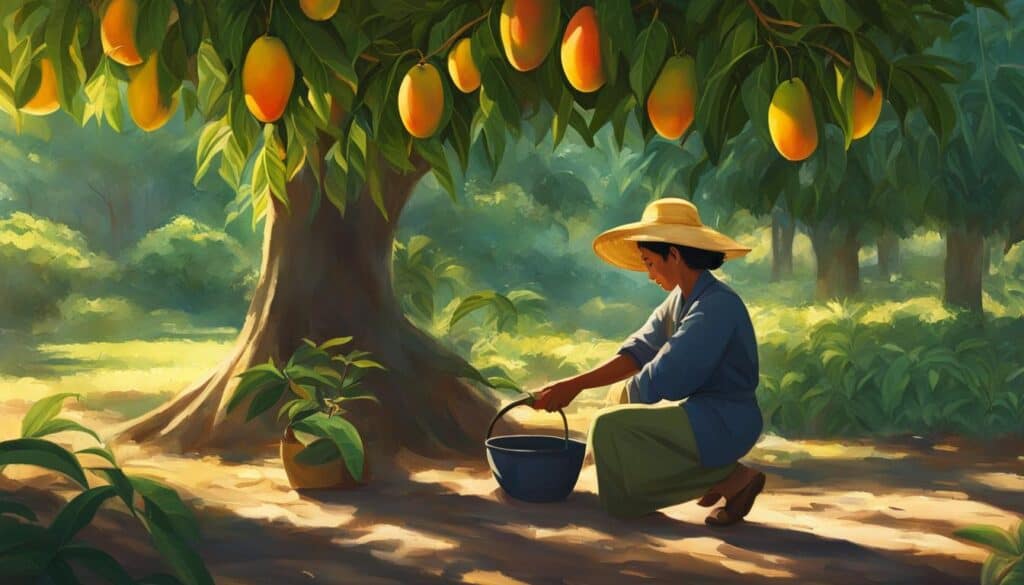
Proper care is essential for the healthy growth and development of a mango tree. By following these guidelines, you can ensure that your mango tree thrives and produces an abundance of delicious fruit.
Planting a Mango Tree
When planting a mango tree, it is important to choose a suitable location that provides full sunlight. Mango trees prefer well-drained sandy to loamy soils. Before planting, prepare the soil by loosening it and removing any weeds or debris. Dig a hole that is slightly larger than the root ball of the tree. Place the tree in the hole, making sure that it is at the same level as it was in the nursery container. Backfill the hole with soil, firming it gently around the roots. Water the tree thoroughly after planting to ensure good establishment.
Maintenance and Care
Regular watering is crucial for the health of a mango tree, especially during dry periods. Water deeply, allowing the soil to dry out slightly between waterings. Mulching around the base of the tree can help retain moisture and suppress weeds. Pruning should be done to remove dead or diseased branches, as well as to shape the tree and promote airflow. Fertilization is important to provide the necessary nutrients for growth. Use a balanced fertilizer formulated for fruit trees and follow the manufacturer’s instructions for application rates.
“Proper care is essential for the healthy growth and development of a mango tree.”
Pest and Disease Control
Mango trees can be susceptible to pests and diseases, including aphids, scale insects, and fungal infections. Regular monitoring is important to detect any signs of infestation or disease. Integrated pest management techniques, such as releasing beneficial insects and using horticultural oils or insecticidal soaps, can help control pests. Disease-resistant varieties are also available and can be planted to minimize the risk of infection. If necessary, consult with a local agricultural extension office or horticultural expert for specific pest and disease management recommendations.
| Care Tips | Benefits |
|---|---|
| Plant in a sunny location | Optimal growth and fruit production |
| Water regularly | Prevents drought stress and enhances fruit quality |
| Prune for airflow | Reduces the risk of disease and increases sunlight penetration |
| Fertilize with balanced nutrients | Promotes healthy growth and abundant fruiting |
| Monitor for pests and diseases | Prevents infestations and minimizes damage |
Common Mango Tree Varieties
When it comes to mango trees, there is a wide variety of options to choose from. Each variety offers its own distinct set of characteristics, including differences in taste, texture, and ripening time. Here are some of the common mango tree varieties:
1. Kensington Pride or Bowen Special
This is the most popular variety in Australia, known for its large size, vibrant orange color, and luscious, juicy flesh. It has a sweet and tangy flavor that is loved by mango enthusiasts.
2. Irwin
The Irwin mango is prized for its smooth, fiberless flesh and sweet, tropical taste. It is a medium-sized mango with a greenish-yellow skin when ripe.
3. Keitt
The Keitt mango is a late-season variety, with a sweet and fruity flavor. It is known for its large size and vibrant green skin, which remains green even when the fruit is ripe.
4. Nam Dok Mai
Originating from Thailand, the Nam Dok Mai mango is highly regarded for its exceptionally sweet and aromatic flesh. It has a thin, yellow skin and is often used in desserts and smoothies.
5. R2E2
The R2E2 mango is a large, oval-shaped fruit with a bright red blush and yellow skin when ripe. It has a sweet and creamy flesh, making it a favorite for eating fresh or in salads.
6. Kent
The Kent mango is known for its rich, sweet flavor and smooth, fiberless texture. It has a greenish-yellow skin with a slight red blush when fully ripe.
These are just a few examples of the many mango tree varieties available. Each variety brings its own unique taste and texture to the table, allowing mango lovers to indulge in a wide range of flavors. Whether you prefer a sweet and tangy mango or a smooth and creamy one, there is a variety out there to suit every taste bud.
| Variety | Taste | Texture | Ripening Time |
|---|---|---|---|
| Kensington Pride or Bowen Special | Sweet and tangy | Juicy | Mid-season |
| Irwin | Tropical and sweet | Fiberless | Mid-season |
| Keitt | Sweet and fruity | Greenish-yellow skin | Late-season |
| Nam Dok Mai | Exceptionally sweet and aromatic | Thin, yellow skin | Mid-season |
| R2E2 | Sweet and creamy | Large and oval-shaped | Mid-season |
| Kent | Rich and sweet | Smooth and fiberless | Mid-season |
Common Mango Tree Diseases
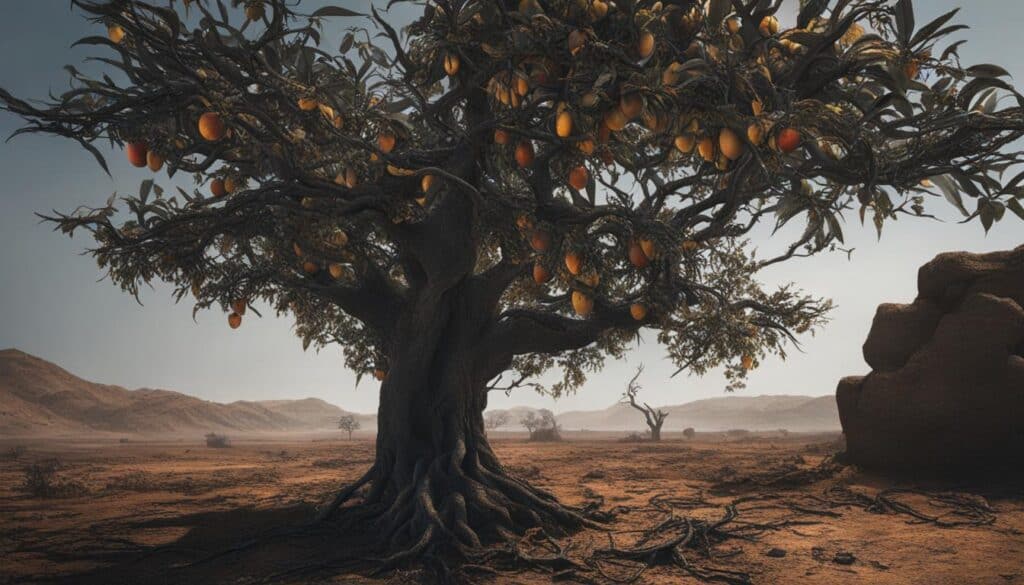
Growing a mango tree comes with its fair share of challenges, including the risk of various diseases. Understanding and recognizing these common mango tree diseases is crucial in order to protect your tree and ensure a bountiful harvest.
Mango Tree Diseases
Here are some of the most common diseases that can affect mango trees:
- Anthracnose: This fungal infection causes dark, sunken lesions on the fruit, leaves, and stems, leading to fruit rot and defoliation.
- Powdery Mildew: A fungal disease that appears as a white powdery coating on the leaves, stems, and fruit, inhibiting photosynthesis and reducing fruit quality.
- Black Spot: This disease manifests as small, black circular spots on the leaves, fruit, and stems, resulting in premature defoliation and reduced fruit yield.
- Bacterial Canker: A bacterial infection that causes raised, corky lesions on the branches, trunks, and fruit, leading to dieback and fruit drop.
Prevention and early detection are key to managing these diseases. Regularly inspecting your mango tree for any signs of infection, such as spots, lesions, or discoloration, can help you take immediate action. Pruning affected branches, improving air circulation, and using disease-resistant varieties are effective measures to control the spread of diseases and protect your mango tree.
| Disease | Symptoms | Prevention and Control |
|---|---|---|
| Anthracnose | Dark, sunken lesions on fruit, leaves, and stems | – Prune affected branches – Apply fungicides – Maintain proper spacing between trees |
| Powdery Mildew | White powdery coating on leaves, stems, and fruit | – Provide adequate spacing and sunlight – Apply fungicides – Remove and destroy infected plant parts |
| Black Spot | Small, black circular spots on leaves, fruit, and stems | – Prune affected branches – Apply fungicides – Improve air circulation |
| Bacterial Canker | Raised, corky lesions on branches, trunks, and fruit | – Prune affected branches – Apply copper-based bactericides – Avoid excessive pruning |
Conclusion
Being aware of the common diseases that affect mango trees and taking proactive steps to prevent and control them can help ensure the health and productivity of your tree. Regular monitoring, proper pruning, and the use of disease-resistant varieties and fungicides are essential in maintaining a thriving mango tree. By staying vigilant and implementing effective disease management strategies, you can enjoy the sweet rewards of a flourishing mango tree in your own backyard.
Pruning Techniques for Mango Trees
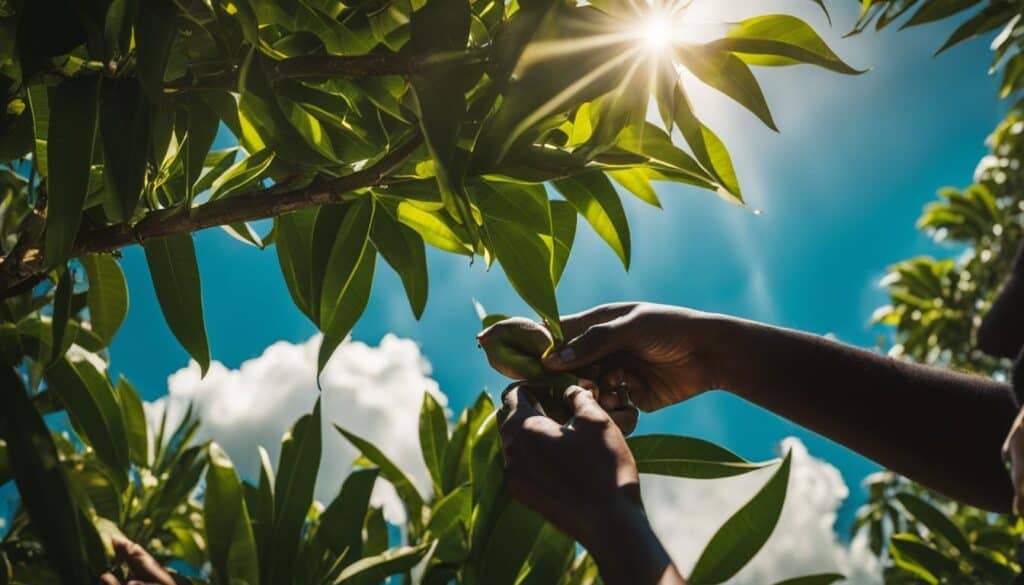
Pruning is a crucial aspect of mango tree care that helps ensure healthy growth, maintain the tree’s shape, and promote abundant fruit production. Proper pruning techniques allow for better airflow and light penetration, reducing the risk of disease and improving overall tree vigor.
When pruning a mango tree, it’s important to remove dead, damaged, or diseased branches, as they can serve as entry points for pests and pathogens. Look for branches that are crossing or rubbing against each other and remove them to prevent injury and promote optimal growth. Additionally, thinning out the canopy by selectively removing some branches allows more sunlight to reach the inner branches, maximizing photosynthesis and promoting fruit development.
It’s recommended to prune mango trees during the early spring or summer months when the tree is actively growing. Make clean cuts just outside the branch collar, the swollen area where the branch meets the trunk or another branch. Avoid leaving stubs, as they can become a breeding ground for pests and diseases.
Pruning Tips:
- Use sharp, clean pruning tools to minimize damage to the tree and reduce the risk of infection.
- Prune back the branches to maintain a height that is manageable for harvesting and overall tree maintenance.
- Consider the natural growth habit of the mango tree when pruning. Mango trees tend to have an open and spreading growth pattern, so avoid excessive pruning that may hinder their natural form.
- After pruning, apply a thin layer of horticultural oil or fungicide to the pruning wounds to protect the tree from pests and diseases.
Remember, proper pruning techniques may vary depending on the specific mango tree variety and local growing conditions. It’s always a good idea to consult resources specific to your region or seek advice from a local horticulturist or arborist for guidance tailored to your specific needs.
How to Grow a Mango Tree from Seed
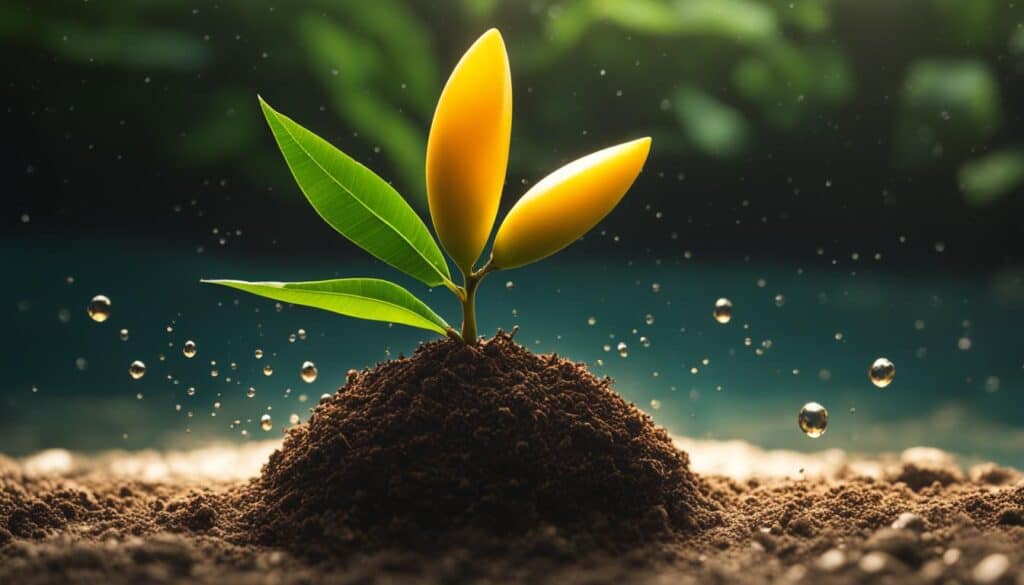
Growing a mango tree from a seed can be a rewarding experience for any gardening enthusiast. Not only will you have the satisfaction of nurturing a plant from its earliest stages, but you’ll also be able to enjoy delicious mangoes straight from your backyard. Here’s a step-by-step guide on how to grow a mango tree from seed:
- Start by selecting a ripe mango and removing the seed from the fruit. Make sure to choose a variety that you enjoy eating, as the seed will produce a tree with similar characteristics.
- With a sharp knife, carefully remove the outer husk of the seed. Be cautious not to damage the inner seed, as this is where the new tree will sprout from.
- Fill a pot with a well-draining potting mix, leaving about an inch of space from the top. Place the mango seed in the potting mix, ensuring that the pointed end is facing downwards.
- Water the potting mix until it is evenly moist but not soaking wet. Place the pot in a warm and sunny location, such as a windowsill or a sunny spot in your garden.
- Keep the potting mix consistently moist by watering whenever the top inch of soil feels dry. Be careful not to overwater, as this can cause the seed to rot.
- Germination can take anywhere from 2 to 4 weeks. Once the seedling has emerged, continue to care for it by providing regular water and sunlight.
- After the seedling has grown to a suitable size, it can be transplanted into a larger container or directly into the ground. Mango trees thrive in tropical climates, so choose a location that receives full sunlight.
It’s important to note that growing a mango tree from seed may not result in the exact same characteristics as the parent tree. Commercially grown mango trees are typically grafted to ensure desirable traits in the fruit. However, growing a mango tree from seed can still be a fun and rewarding project. So why not give it a try?
Remember, patience is key when growing a mango tree from seed. It may take several years for your tree to bear fruit, but the wait will be well worth it. So roll up your sleeves, grab a pot, and get ready to cultivate your very own mango tree.
Fertilization Tips for Mango Trees
Proper fertilization is essential for ensuring the healthy growth and fruit production of mango trees. By providing the right nutrients at the right time, you can help your mango tree thrive and bear delicious fruits. Here are some important tips to keep in mind when fertilizing your mango tree:
1. Choose the right fertilizer
When selecting a fertilizer for your mango tree, opt for a balanced formula with a ratio of nitrogen, phosphorus, and potassium (NPK) of 10-10-10 or 14-14-14. This will provide a well-rounded blend of nutrients that the tree needs for optimal growth. Look for fertilizers specifically formulated for fruit trees or tropical plants.
2. Apply fertilizer at the right time
It’s best to apply fertilizer to your mango tree in the early spring, just before new growth begins. This allows the tree to take advantage of the nutrients as it starts its active growth phase. Avoid fertilizing during winter or late fall, as the tree is dormant during this time.
3. Follow the manufacturer’s instructions
Always follow the manufacturer’s instructions when applying fertilizer to your mango tree. This includes the recommended application rates and frequency. Over-fertilization can lead to excessive vegetative growth and may reduce fruit production. It’s important to strike the right balance to ensure a healthy tree and a bountiful harvest.
4. Monitor soil pH and nutrient levels
Regular soil testing can help you determine the specific nutrient needs of your mango tree. The ideal pH range for mango trees is between 6.0 and 7.0. If the pH is too high or too low, it can affect nutrient availability to the tree. Soil tests can also reveal any deficiencies or excesses of certain nutrients, allowing you to make targeted adjustments to your fertilization routine.
Remember, each mango tree is unique, and factors such as soil type, climate, and tree age can influence its nutrient requirements. By understanding the basics of fertilizing mango trees and tailoring your approach to the specific needs of your tree, you can ensure healthy growth, abundant fruit production, and a thriving mango tree in your backyard.
Managing Mango Tree Pests
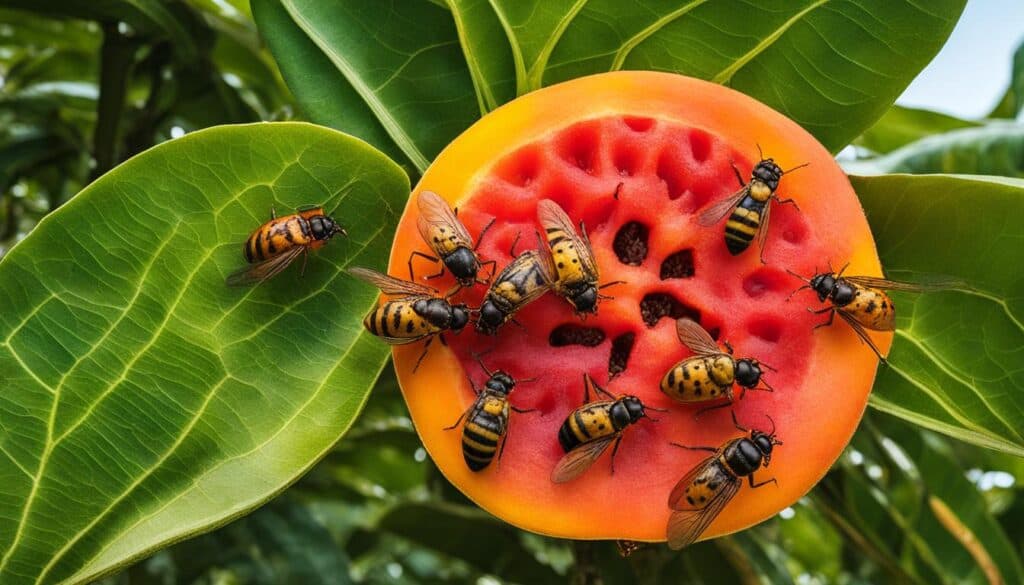
Mango trees, like any other plant, can face challenges from various pests that can hinder their growth and fruit production. It is important to monitor and manage these pests to ensure the health and vitality of your mango tree. Here are some common pests that can affect mango trees and ways to address them:
Aphids
Aphids are small insects that feed on the sap of mango trees, causing distorted growth, yellowing leaves, and the formation of a sticky substance called honeydew. To control aphids, you can introduce natural predators like ladybugs or lacewings into your garden. Alternatively, you can use insecticidal soaps or horticultural oils to reduce aphid populations. Regularly inspect your mango tree and take action at the first sign of an infestation.
Scale Insects
Scale insects are another common pest that can attack mango trees. They often appear as small bumps or scales on the branches and leaves. Scale insects feed on the sap of the tree and can cause leaf yellowing, stunted growth, and premature leaf drop. To manage scale insects, you can gently scrub the affected areas with a soft brush and soapy water. In severe cases, horticultural oils or insecticides labeled for scale insects can be used.
Fruit Flies
Fruit flies are a common pest that can damage mango fruit. They lay their eggs in the fruit, which then hatch into maggots that feed on the flesh, causing it to rot. To reduce fruit fly damage, you can use fruit fly traps or baits. These traps attract and capture the flies, preventing them from laying eggs in your mangoes. Additionally, practicing good orchard sanitation by removing fallen or damaged fruit can help reduce fruit fly populations.
| Pest | Description | Control Methods |
|---|---|---|
| Aphids | Small insects that feed on sap, causing distorted growth and leaf yellowing | Introduce natural predators, use insecticidal soaps or horticultural oils |
| Scale Insects | Small bumps or scales on branches and leaves, causing leaf yellowing and stunted growth | Gently scrub affected areas, use horticultural oils or insecticides |
| Fruit Flies | Lay eggs in fruit, maggots feed on flesh, causing fruit rot | Use fruit fly traps or baits, practice good orchard sanitation |
By actively managing these pests and promptly addressing any signs of infestation, you can minimize their impact on your mango tree. Remember to always follow the instructions on any pest control products and use methods that are least toxic to beneficial insects and the environment. With proper pest management, your mango tree can thrive and reward you with bountiful harvests.
Conclusion
The mango tree is truly a remarkable gift from nature. Not only does it provide us with delicious and nutritious fruit, but it also adds beauty and tranquility to our surroundings.
By following proper care techniques, such as planting in the right location, regularly watering, and providing adequate nutrition, we can ensure the health and productivity of our mango trees. Pruning and managing pests are also important aspects of mango tree care.
So, why not embrace the sweet serenity beneath the mango tree? Create your own tropical oasis in your backyard and savor the flavors of this remarkable fruit. The mango tree is not only a symbol of nature’s abundance but also a source of joy and fulfillment.
FAQ
What is the significance of the mango tree in India?
The mango tree is considered sacred in India and is believed to hold spiritual significance. It is said that Buddha used to meditate under a mango tree.
What are the health benefits of mangoes?
Mangoes are a rich source of vitamin C, beta carotene, and dietary fiber. Vitamin C boosts the immune system, promotes healthy skin, and helps in the absorption of iron. Beta carotene is converted into vitamin A and is essential for good vision, healthy skin, and a strong immune system. Dietary fiber aids in digestion and helps maintain a healthy weight.
How do I care for a mango tree?
Mango trees thrive in tropical climates and prefer well-drained sandy to loamy soils. They should be planted in an area that receives full sunlight and regularly watered. Pruning should be done to remove dead or diseased branches and to shape the tree. Fertilization is important to provide the necessary nutrients for healthy growth.
What are some common mango tree varieties?
In Australia, the most common variety is the Kensington Pride or Bowen Special mango. Other varieties include the Irwin, Keitt, Nam Dok Mai, R2E2, and Kent mangoes. These varieties differ in taste, texture, and ripening time.
What are the common diseases that affect mango trees?
Mango trees can be affected by diseases such as anthracnose, powdery mildew, black spot, and bacterial canker. Proper care, including regular pruning and the use of disease-resistant varieties, can help prevent and control these diseases.
How should I prune a mango tree?
Pruning should be done during the early spring or summer months when the tree is actively growing. Dead or diseased branches should be removed, along with any branches that are crossing or rubbing against each other. Clean cuts should be made to minimize damage to the tree.
How do I grow a mango tree from seed?
To grow a mango tree from seed, remove the seed from a ripe mango and plant it in a potting mix with the pointed end facing downwards. Keep the soil moist and place the pot in a warm and sunny location. Germination can take 2 to 4 weeks.
How should I fertilize a mango tree?
A balanced fertilizer with a ratio of nitrogen, phosphorus, and potassium (NPK) of 10-10-10 or 14-14-14 is recommended. Fertilizer should be applied in the early spring, before new growth begins. Follow the manufacturer’s instructions for application rates and timing.
How can I manage pests that affect mango trees?
Regular monitoring is important to identify early signs of pest infestation. Natural predators, horticultural oils, and insecticidal soaps can be used to control pests like aphids, scale insects, mealybugs, and fruit flies. Fruit fly traps and baits can also help reduce fruit damage.





Leave a Reply